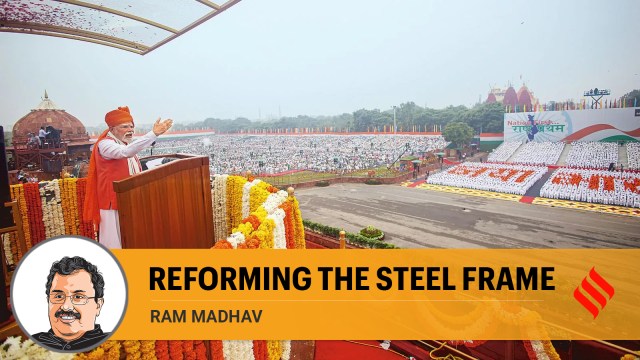
On Independence Day last week, Prime Minister Narendra Modi delivered an important address from the Red Fort’s ramparts. There was greater emphasis on a grand vision for the future of the nation this time compared to the past, especially the direction the country should take in the coming years. PM Modi focused a lot on areas in frontier technology and insisted on making the country atmanirbhar (self-reliant) in these areas. He talked about semiconductors, nuclear energy, clean energy, critical minerals, oil exploration, EVs, even jet engines, and asked, “Should the jet engine for our Made in India fighter jets be ours or not?”
The Prime Minister promised citizens that the country will shed dependency in the next two decades. He explained self-reliance as “not confined merely to imports and exports, or to rupees, pounds, and dollars”, but “linked to our capability”, calling upon countrymen to “preserve, maintain, and enhance our capability, it is imperative to be self-reliant”.
However, most of this digitisation came from low-tech and mid-tech areas of basic computing and social media. In high-tech areas, India has registered some advancements in the last two decades, with cities like Bengaluru, Hyderabad, Pune, Gurugram, and others emerging as hubs of such technologies. Yet, several high-tech areas remain heavily import-dependent. Meanwhile, as we race ahead in mid-tech and high-tech areas, the world has moved on to the next level of deep-tech, Web 4.0, for instance. PM Modi wants the country to focus on areas such as artificial intelligence, quantum computing, robotics, blockchain technologies, genetics and bioengineering, aerospace and defence, space and outer space and crypto and other digital currencies.
It is a tall order. It’s not that India lacks capability. Global leaders in deep-tech like Nvidia and IBM have R&D facilities in India, benefiting from the country’s talent pool. But there are some fundamental challenges that the country needs to address to achieve atmanirbharta in deep-tech. PM Modi appeared conscious of that imperative. A day after his Independence Day address, PM Modi called a high-level meeting of his senior cabinet colleagues and others to discuss “next-generation reforms”.
Next-generation reforms are crucial. But what is more crucial is for the government to look at the pending basic reforms in three important sectors — the bureaucracy, regulatory bodies, and the judiciary. In his address from the Red Fort in 2022, PM Modi had called on the people to shed “all traces of the colonial mindset”. Incidentally, these three institutions continue to dominate governance in our country. Not that the individuals who work in these institutions — bureaucrats and judicial officers — are incompetent. Many of them have proved to be outstanding and won laurels for the nation. But the challenge is with the systems we inherited from the British colonisers.
The Westminster bureaucracy we adopted without change after Independence was created by colonial administrators to perpetuate British rule in India. Nearly every civil servant came from London till the first two decades of the 20th century. To increase the demand for them, the Public Service Commission was created in 1926 to train Indians for bureaucratic positions. But the Indian Civil Service’s design, the “steel frame”, continued to ensure that Indians remained subservient to an unelected and unaccountable institutional framework. Incidentally, 2026 marks the centenary of this British vintage institution. There cannot be a better occasion to overhaul the UPSC.
There have been several attempts at administrative reforms in the past. The Veerappa Moily Committee, appointed during the UPA government in 2005, was the last. Its important suggestions include introducing “direct appointment of specialists with domain expertise for high-ranking government positions” and “establishing a code of ethics for public officials and a mechanism for accountability”. However, not much has happened in that direction. Prime Minister Modi’s efforts to encourage the lateral entry of experts, too, have met with limited success in cracking the “steel frame”. Earlier this year, the government formed a Deregulation Commission to identify and eliminate redundant compliance obligations in various sectors. Its aim was to end regulatory red tape. PM Modi’s grand vision depends on how he tackles these tough bureaucratic and regulatory roadblocks.
Two countries that lead the world today, China and the US, have different bureaucratic models. But one common feature between them is the supremacy of the political leadership. Even in the UK, from where we inherited the Westminster model, a major debate erupted a few years ago over the steel frame’s efficacy. Dominique Cummings, chief advisor to the then UK Prime Minister Boris Johnson, led the campaign for bureaucratic reforms. Objecting to the internal promotion model, he pushed for opening senior appointments to outside competition. Besides fixing accountability, he also advocated for greater ministerial control over the administration.
There can be a debate over the merits of these suggestions. But for Viksit Bharat to become a reality, an undeniable imperative for India is to shed its colonial bureaucratic model and replace it with a more accountable and responsive institutional arrangement.
The writer, president, India Foundation, is with the BJP. Views are personal